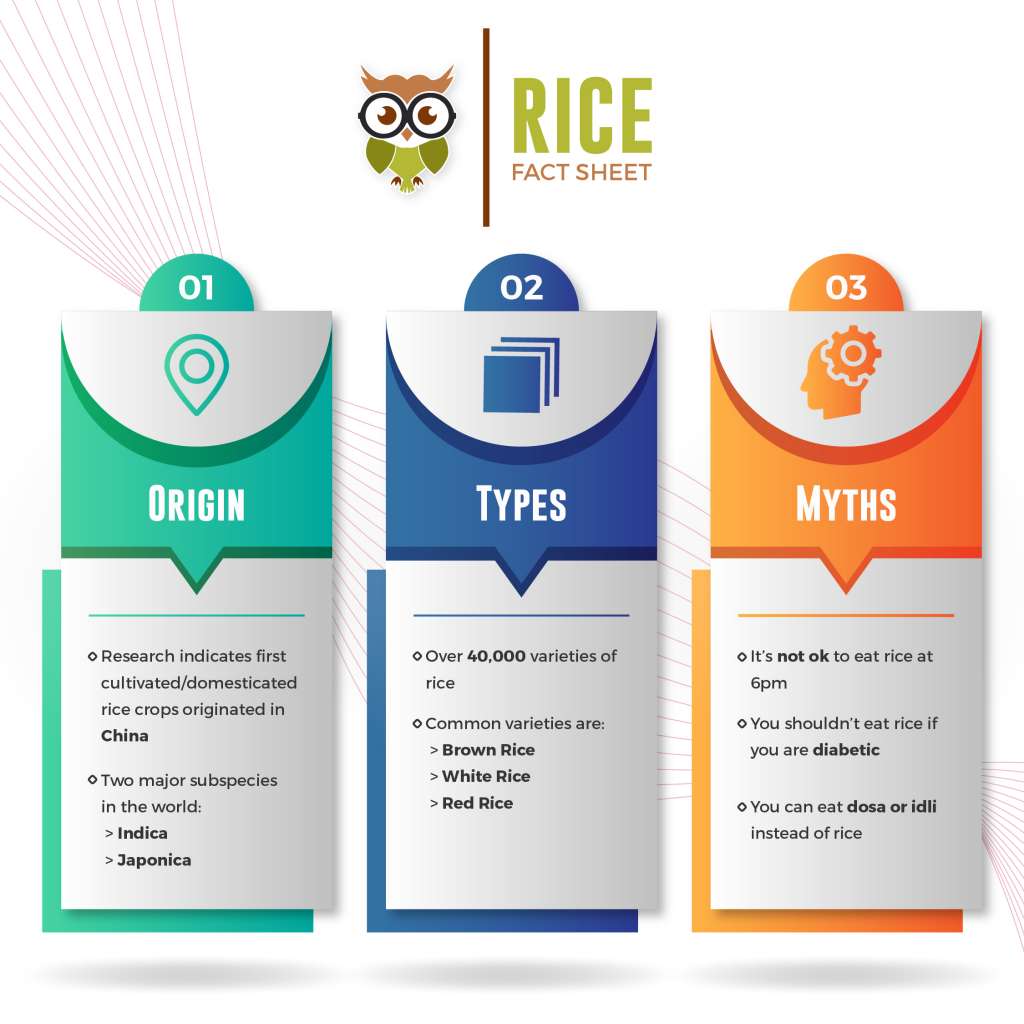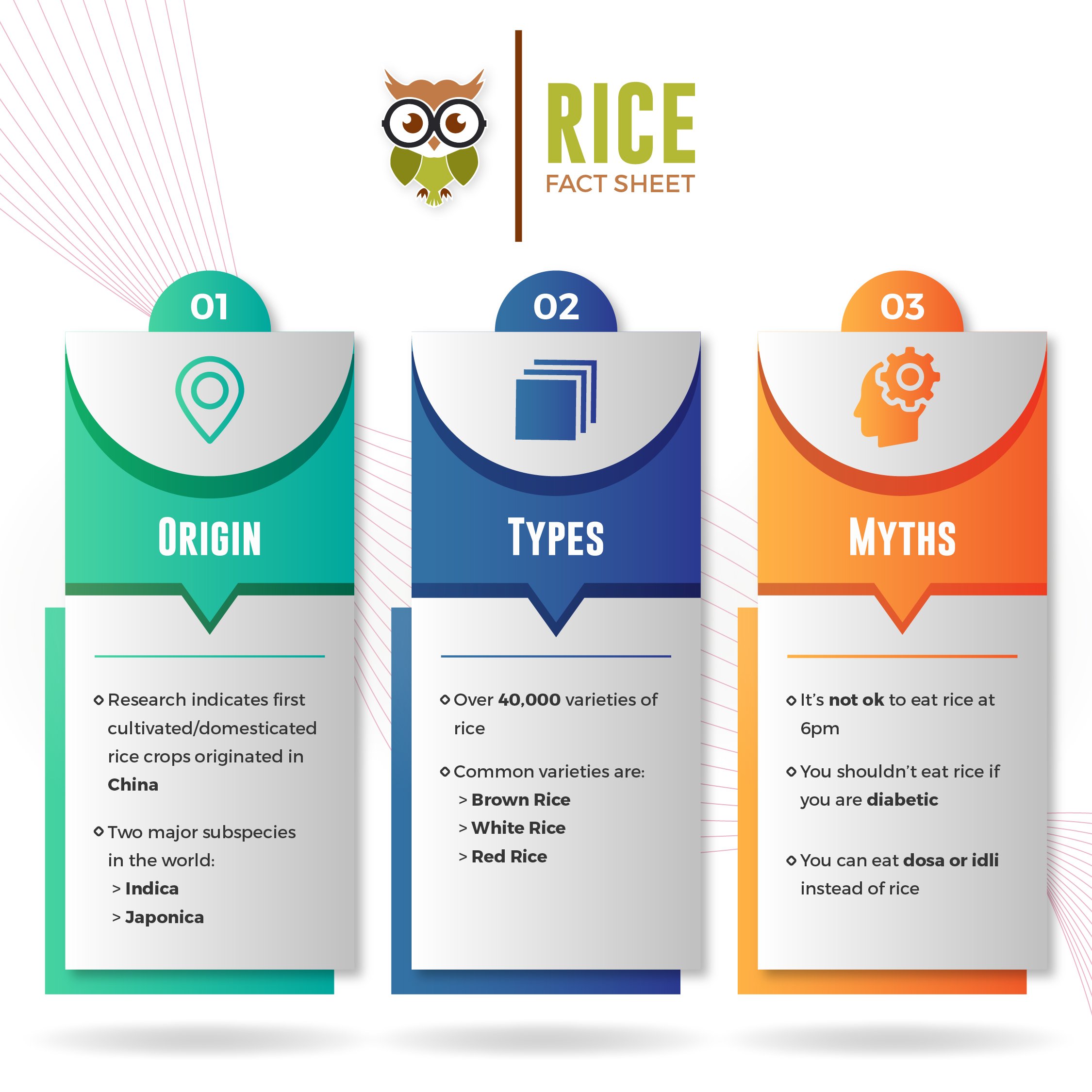Basics of Rice
Rice has been the staple food for us in India for ages and also for the most part of Asia. Though this has been the natural trend, a lot of fear and speculation have risen over this wonderful crop due to misinformation and twists of truth. I plan to outline the basics and bust some myths in this blog post.

What are the origins of Rice?
Based on archaeological evidence, the earliest occurrence of Rice can be traced back along the Yangzi River Valley of China dated back to 11,000–12,000 BC (1).Two of the most common domesticated sub-species of Rice are indica and japonica. Rice plays a major role in India and is cultivated in more than a quarter of the agriculture land in the country. There has been an explosion in the variety of rice cultivated in India and includes but is not limited to Basmati rice, Ponni Rice, Hansraj, etc.,
Where are we going wrong?
Though we’ve been consuming Rice as a staple for centuries, there’s been a sudden boom in speculation over the consumption of rice and its link to lifestyle diseases such as Obesity and Diabetes. But have you heard of the Okinawa Diet?
People belonging to the Okinawa Island and a few surrounding islands of Japan have some of the highest recorded life expectancy in the world (2). But the fact remains that rice is a daily staple for the people belonging to this region. The highlight here is the proportion of rice to vegetables and other macros. The Okinawa Diet is not about including or excluding certain food items but it is an eating style.
The important takeaway here is to make sure you practice good portion control and include enough vegetables and good protein souces in your diet along with the right amounts of rice.
What are the types of Rice and how do I choose?
From the 2 subspecies of rice, there are siad to be over 40,000 varieties of rice. The most commonly known forms of rice are White Rice, Brown Rice and Red Rice.
The rice grain consists of 3 parts – the bran, the germ and the endosperm. Brown Rice is unprocessed rice that contains all three parts of the grain while white rice is processed to remove the bran and the germ giving it a cleaner whiter look. Brown rice is slightly higher in dietary fiber and certain micronutrients and contains a much lower glycemic index than white rice (4,5).
Red rice is another variety which is high in a compound known as anthocyanins. This compound confers antioxidant properties to red rice. It is also commercially available as hulled and unhulled grains.
So which one do I choose? Although each of these rice have their pros and cons, it all comes down to your personal choice. Even if a few varieties have a few nutritional benefits, it doesn’t outweigh the other choices as long as you’re maintaining portion control and getting all the nutrients you need from other sources.
Now I’d like to address some of the common myths associated with rice starting with the most common one:
Will eating rice after 6 pm cause me to put on more weight than usual?
There is no link between eating certain foods after a certain time and putting on weight. Whether you’re eating at 6 am or 6 pm the energy content of rice and all other food items remain the same. What you need to ask yourself is whether this cup of rice I’m about to eat fits within your day’s macro requirement or you’re going overboard.
Is it ok to eat rice when you’re diabetic?
Another common misconception is that it’s a sin to eat carbs if you’ve been diagnosed with diabetes and you should avoid rice at all cost. This makes no sense as the alternative given is rotis and other such options which again are full of carbs. What’s important in such conditions is to practice portion control by reducing your rice intake and substituting with vegetables. There is no need to avoid rice altogether.
Are Dosa and Idlis better alternatives to rice?
Here’s another simple thing that people get confused about. The fact remains that one of the major components for making these dishes is rice. Not just that, the dal used to make these batters aren’t just a source of protein. They are also loaded with carbs! Not saying that either is better or worse. The fact is it doesn’t really make a huge difference.
References
1) Megan Sweeney, Susan McCouch, The Complex History of the Domestication of Rice, Annals of Botany, Volume 100, Issue 5, October 2007, Pages 951–957
2) Boyle, Marie A.; Long, Sara (2008), Personal Nutrition (7 ed.), Stamford
3) https://farmer.gov.in/cropstaticsrice.aspx
4) Glycemic index for 60+ foods
5) Glycaemic Index (GI) of an Indian Branded Thermally Treated Basmati Rice Variety : A Multi Centric Study



